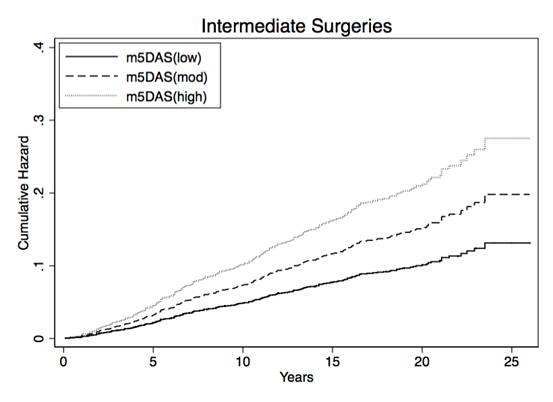Session Information
Title: Rheumatoid Arthritis - Clinical Aspects III: Malignancies, Vaccinations, Pregnancy and Surgery
Session Type: Abstract Submissions (ACR)
Background/Purpose:
It is well-established that sustained high disease activity in RA results in worse outcomes. In reality many patients remain in low/moderate disease activity states, yet their outcomes, especially in the long term, are less well studied.
Methods:
The study was based on the Early RA Study (ERAS, n=1465, 1986-1999) and the Early RA Network (ERAN, n=1236, 2002-2012). Standard clinical, radiological and laboratory measures were performed yearly for a maximum (median) 25(10) and 10(3) years respectively. Clinical databases were validated with national sources: the National Joint Registry (2003-2011), Hospital Episode Statistics (1997-2011) & National Death Register (1986-2011). Treatment regimens followed guidelines of the era, mainly conventional DMARDs +/- steroids, and latterly biologics. Joint interventions were categorized into major (large joint replacements), intermediate (mainly synovectomies and arthroplasties of wrist/hand, hind/forefoot) or minor (mainly soft tissue). Mean DAS was calculated for each patient from year 1 to 5 and categorized into either sustained low [m5DAS(low)] moderate disease [m5DAS(mod)] or high [mDAS(high)] disease activity if DAS28 was persistently lower than 3.2, between 3.2-5.1 or greater than 5.1 respectively.
Results:
Of 2321 (86%) with complete 5year DAS data, 854 (37%) had m5DAS(low), 1066 (46%) m5DAS(mod) and 401 (17%) m5DAS(high). 770 (29%) patients had undergone a total of 1602 procedures over the 25 years of study; cumulative incidence rate of major interventions was 21.7% (19.4-24.0%) and of intermediate 21.5% (17.8-25.5%). In multivariate Cox regression models controlling for age at disease onset, gender, recruitment year, symptom duration, rheumatoid factor, BMI, HAQ, Haemoglobin, ESR and baseline erosions, patients with m5DAS(low) were 44% and 46% less likely to have intermediate and major joint surgery respectively compared to patients with moderate disease activity over the first 5 years (P<0.05). Patients with m5DAS(high) were 49% more likely to have intermediate surgery than those with m5DAS(mod) over the first 5 years (P<0.05) (Figure 1). A similar trend was observed for major surgery, but statistical significance was not reached.
Conclusion:
Patients with sustained moderate disease activity in the first 5 years of disease, despite conventional DMARD therapy, still remain at high risk of joint failure and surgery. This poses important management challenges in health systems where restrictions exist in the use of biologic DMARDs, which are based on DAS28 levels and exclude moderate RA. The results demonstrate that any therapy that keeps patients in low disease activity or remission states is beneficial in terms of long-term outcomes.
Figure 1.
Disclosure:
E. Nikiphorou,
None;
L. Carpenter,
None;
S. Norton,
None;
J. Dixey,
None;
P. Kiely,
None;
D. Walsh,
Pfizer Inc,
2;
A. Young,
None.
« Back to 2014 ACR/ARHP Annual Meeting
ACR Meeting Abstracts - https://acrabstracts.org/abstract/eventual-joint-failure-and-surgery-rates-in-rheumatoid-arthritis-remain-high-in-patients-with-moderate-disease-activity-in-the-first-5-years-of-disease/

